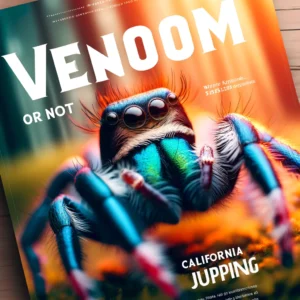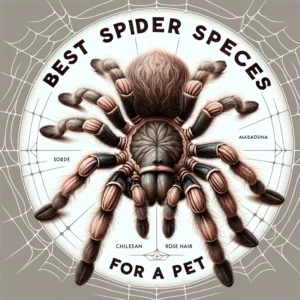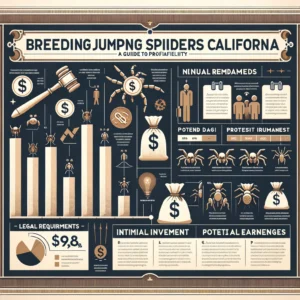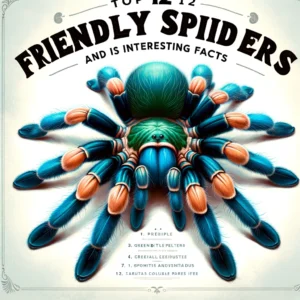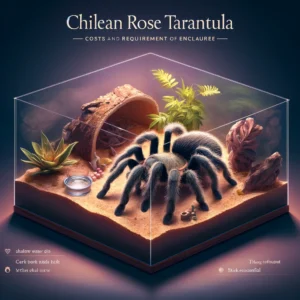Jumping spiders, with their charismatic behaviors and distinctive appearances, make fascinating pets for enthusiasts and casual observers alike. Belonging to the family Salticidae, which boasts over 5,000 species, these spiders are known for their incredible jumping ability and surprisingly keen eyesight. This article delves into why jumping spiders can be great pets, how to care for them, and what to consider before bringing one into your home.
Why Choose a Jumping Spider as a Pet?
Unique Behavior and Intelligence
Jumping spiders are highly visual hunters that rely on their acute eyesight to spot prey movements from long distances. They are known for their curiosity, which can be quite entertaining—they often track human movement as well, turning their heads to keep people in sight.
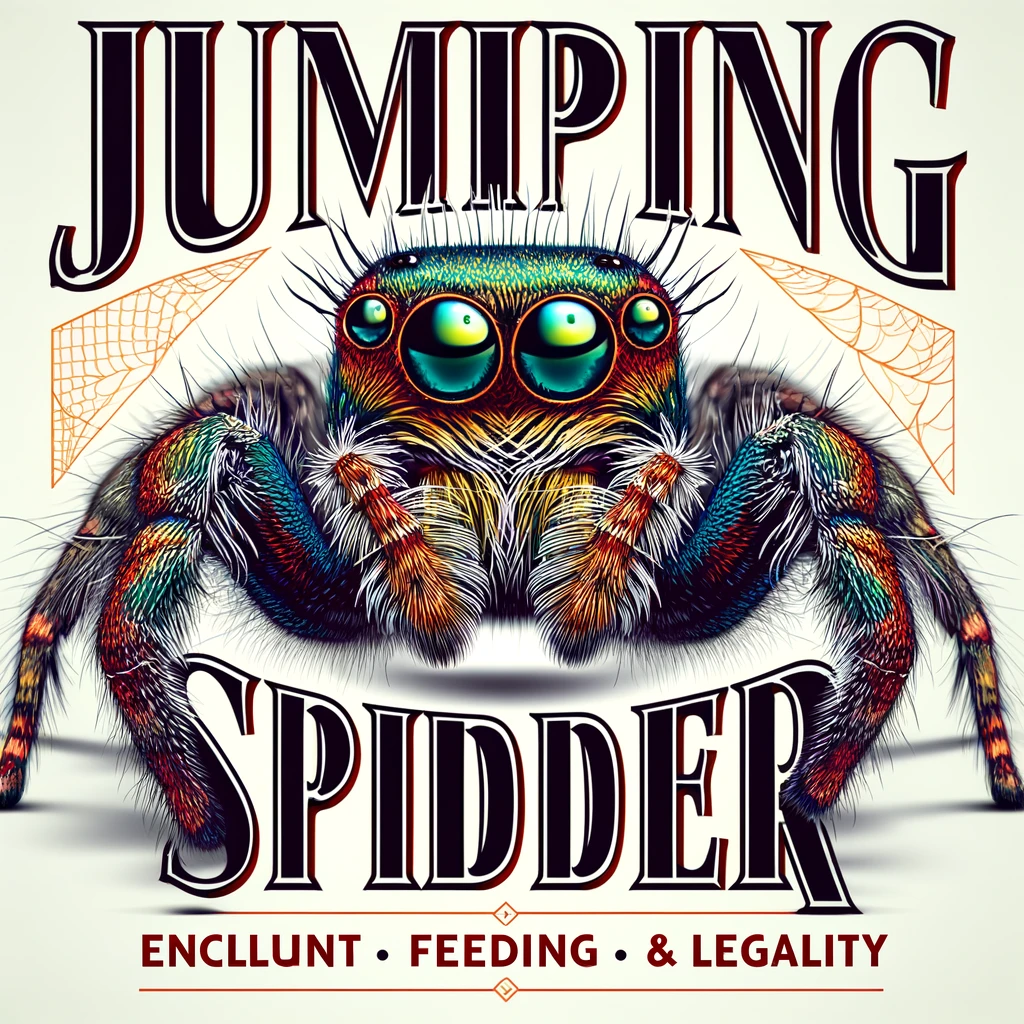
Enclosure Setup for Jumping Spiders
Jumping spiders require a habitat that not only mimics their natural environment to some extent but also ensures their safety and comfort. Here’s a detailed guide on setting up an appropriate enclosure for your jumping spider pet:
Choosing the Right Enclosure
Type of Enclosure
- Clear Containers: A clear plastic or glass container works best as it allows you to observe your spider without disturbance. Containers like Kritter Keepers, small aquariums, or even large mason jars are suitable options.
- Size: The enclosure should be at least three times the leg span of the spider in height, and twice its leg span in width. A good rule of thumb for a typical jumping spider is 10 inches wide by 10 inches tall.
Ventilation
- Lid: The lid must be secure to prevent escapes, as jumping spiders are excellent at finding small gaps. Use a lid with fine mesh or drill small holes in a plastic lid for air circulation.
Setting Up the Inside of the Enclosure
Substrate
- Purpose: The substrate helps maintain humidity, which is crucial for the spider’s hydration and successful molting.
- Materials: Peat moss, coconut fiber, or chemical-free potting soil are ideal choices. The substrate should be a few inches thick to retain moisture.
- Maintenance: Change the substrate every few months or as needed to prevent mold and bacterial growth.
Furnishings
- Climbing Structures: Provide sticks, bark, plants, or cork pieces for the spider to climb on. Jumping spiders are active hunters and enjoy climbing.
- Hiding Spots: Create hiding spots using curled leaves, small containers on their side, or even tissue paper rolls. These provide security and mimic the small crevices they might find in nature.
- Web Anchors: Although not web weavers for catching prey, jumping spiders will use silk for safety lines and molting mats, so include some twigs or leaves for them to anchor their silk.
Temperature and Humidity
Temperature
- Ideal Range: Keep the enclosure at room temperature, typically between 68°F to 78°F (20°C to 26°C). Avoid placing the enclosure near heaters, air conditioners, or direct sunlight to prevent extreme temperature changes.
Humidity
- Moisture Source: A shallow water dish with clean water can be provided, although jumping spiders rarely drink from open water. Instead, mist the enclosure lightly every few days to maintain humidity.
- Monitoring: Use a small hygrometer within the enclosure to keep track of humidity levels. The ideal humidity should be between 65% to 75%.
Lighting
- Natural Light: Jumping spiders do well under natural light as long as the enclosure is not in direct sunlight, which could overheat it.
- Artificial Light: If natural light is insufficient, a simple LED or standard room lighting will suffice, mimicking a day and night cycle.
Safety Precautions
- Escape-Proofing: Ensure there are no gaps or holes in the enclosure larger than the spider’s body. Regularly check the integrity of the enclosure.
- Chemical Safety: Avoid using any chemicals inside or near the enclosure, such as cleaners or insecticides, which can be harmful to the spider.
Regular Maintenance
- Cleaning: Wipe down the interior surfaces with a damp cloth every few weeks. Avoid harsh detergents.
- Substrate Replacement: Change the substrate entirely every 2-3 months to prevent fungal or bacterial issues.
- Furnishing Adjustments: Periodically change or rearrange the furnishings to clean them and to keep the environment stimulating for the spider.
Setting up and maintaining a proper enclosure for a jumping spider is not just about replicating their natural habitat but also about ensuring they have a safe, comfortable, and stimulating environment to thrive in. Regular care and maintenance of the habitat will help keep your spider healthy and active. With the right setup, jumping spiders can make intriguing and engaging pets.

Diet and Feeding of Jumping Spiders
Jumping spiders are carnivorous and primarily hunt live prey. They possess excellent vision, which they use to spot and stalk prey before capturing it with a quick leap. Understanding the dietary needs and feeding strategies of jumping spiders is crucial for their health. Here’s a detailed breakdown of their diet and feeding recommendations:
What to Feed
Preferred Prey
- Insects: The diet of a jumping spider should mainly consist of small insects such as:
- Fruit flies (particularly for smaller or younger spiders)
- Houseflies
- Small crickets
- Moths
- Small beetles
Live Feeding
- Jumping spiders require live prey to stimulate their hunting instinct. They are more likely to eat their food if it is moving, which triggers their predatory response.
Feeding Frequency
Adults
- Frequency: Adult jumping spiders should be fed every two to three days. Overfeeding can lead to health issues, so it’s important to monitor their feeding closely.
- Quantity: 1-2 small insects per feeding session is sufficient. This quantity ensures they receive enough nutrition without the risk of overfeeding.
Juveniles
- Frequency: Juvenile spiders need more frequent feeding to support their growth, typically once a day.
- Quantity: Feed small prey like fruit flies or tiny crickets. Juveniles are at risk of dehydration and low energy if not fed adequately.
Hydration
Water Needs
- Water Dish: While jumping spiders rarely drink from a water dish, having a shallow dish of water can help maintain humidity levels, which indirectly aids their hydration.
- Misting: Misting the enclosure lightly every few days is recommended. The spider can drink the droplets from plant leaves or the enclosure walls, which also helps in keeping them hydrated.
Observing Your Spider
Signs of a Healthy Diet
- Activity Levels: A well-fed jumping spider is active and alert. If your spider is lethargic or uninterested in prey, it may be a sign of illness or poor diet.
- Abdomen Size: The abdomen should not be swollen or shrunken; both can indicate health issues (overfeeding or starvation, respectively).
Adjustments
- If your spider is not eating, consider the following adjustments:
- Prey Size: Ensure the prey items are not too large for the spider to handle.
- Prey Type: Some spiders may prefer certain types of insects over others. Observing your spider’s preferences can be key.
- Feeding Times: Experiment with different times of day. Jumping spiders are diurnal (active during the day), so they are more likely to hunt in daylight hours.
Special Considerations
Molting
- Increased Needs: A jumping spider will have increased nutritional needs just before it molts (sheds its exoskeleton to grow). It may eat more or less during this time.
- Post-Molt: Provide a humid environment and do not feed your spider for several hours to a day after molting, as their new exoskeleton needs time to harden.
Seasonal Adjustments
- Winter Months: Some spiders may eat less or become less active during winter months if the room temperature is cooler, mimicking their natural seasonal behaviors.
Proper diet and feeding are critical to maintaining your jumping spider’s health. By ensuring they have access to appropriate prey and are fed at regular intervals, your spider should thrive in captivity. Observing their behaviors and adjusting their diet as needed can help prevent health issues and keep your spider active and healthy.

Cost Summary for Keeping a Jumping Spider as a Pet
Jumping spiders are among the most affordable pets, not only in terms of initial setup but also ongoing maintenance. Here’s a breakdown of the costs associated with keeping a jumping spider:
Initial Setup Costs
- Enclosure:
- Type: Clear container (e.g., Kritter Keeper, small aquarium, large jar)
- Cost: $10 to $30 depending on size and type
- Substrate:
- Type: Peat moss, coconut fiber, or chemical-free potting soil
- Cost: $5 to $10 for a bag that can last several changes
- Decorations:
- Type: Plants, sticks, bark, cork for climbing and hiding
- Cost: $5 to $20, depending on complexity and naturalistic setup desires
- Water Dish and Misting Bottle:
- Cost: $1 to $5 for a simple dish and spray bottle
- Hygrometer:
- Type: Device to measure humidity
- Cost: $5 to $15
Ongoing Monthly Costs
- Feeding:
- Prey: Insects such as fruit flies, houseflies, and small crickets
- Cost: $10 to $30 per month, depending on the type and quantity of insects purchased
- Substrate Replacement:
- Frequency: Every 2-3 months (cost spread over months)
- Monthly Cost: Around $1 to $3
- Miscellaneous:
- Includes: Occasional replacement of decorations, water dish, or the enclosure itself
- Monthly Cost: $1 to $5
Annual Costs
- Total Initial Setup:
- Range: $26 to $85 (one-time purchase for basic setup)
- Total Ongoing Costs:
- Monthly: $12 to $38 (includes feeding and minor replacements)
- Yearly: $144 to $456
Additional Potential Costs
- Veterinary Care:
- Need: Rare; most spiders will not require veterinary care, but emergencies can happen
- Cost: Can vary widely if needed; generally, consultation/examination fees start around $50
- Travel Container:
- Purpose: For safely transporting the spider, if necessary
- Cost: $5 to $15
Cost-Effective Tips
- DIY Enclosures: Consider converting existing containers at home into spider habitats.
- Homemade Prey Cultures: Start your own fruit fly culture to reduce the cost of buying feeder insects.
- Natural Decor: Use natural items from safe, pesticide-free areas instead of buying all new decorations.

Legality of Keeping a Jumping Spider as a Pet
Keeping a jumping spider as a pet can be a fun and educational experience, but it’s essential to be aware of the legal aspects involved. The legality of owning a jumping spider varies depending on local and international laws. Here’s what you need to consider:
1. Local Laws and Regulations
- City and State Regulations: In many places, particularly within the United States and Europe, keeping spiders as pets is legal. However, specific cities or states may have regulations regarding the types of species you can keep, especially concerning native vs. exotic species.
- Permits: Some regions may require a permit for keeping exotic species, including certain types of spiders. It’s essential to check with local wildlife agencies or regulatory bodies to ensure you comply with any required permits or registrations.
2. International Laws
- CITES Regulations: The Convention on International Trade in Endangered Species of Wild Fauna and Flora (CITES) regulates the international trade of wildlife species, including some spiders. If you are considering importing a spider from another country, you need to ensure that the species is not protected under CITES or that you have the proper permits for trade.
- Import and Export Controls: Many countries have strict controls on the import and export of live animals, including spiders, to protect native species and prevent the spread of invasive species. Compliance with these controls is crucial to avoid legal issues.
3. Protected Species
- Endangered Species: Some spider species are protected under national or international law due to their status as endangered. Keeping a protected spider as a pet could be illegal and subject to severe penalties.
- Checking Status: Always verify the conservation status of the species you wish to keep. This information can usually be found on environmental protection agency websites or through international organizations like the IUCN Red List.
4. Ethical Considerations
- Source of the Spider: Ethically, it is advisable to acquire spiders that have been bred in captivity rather than those taken from the wild. Wild-caught spiders can contribute to declining populations and may also be more stressed and prone to health issues in captivity.
- Impact on Biodiversity: Introducing non-native species to a new environment (even if kept indoors) can pose a risk if those animals escape. Such species can become invasive and disrupt local ecosystems.
5. Practical Tips for Ensuring Legality
- Contact Authorities: Before purchasing a jumping spider, contact local wildlife authorities or a veterinarian familiar with exotic pets to get the most accurate and up-to-date information on legality.
- Reputable Sellers: Purchase spiders from reputable sellers who comply with local and international laws. These sellers should also provide accurate information about the spider’s origin.
- Documentation: Keep all documents related to your pet’s purchase, including any permits, certificates of origin, and health certificates. This documentation will be crucial for proving the legality of your pet in case of inspections.

Quick Overview of Jumping Spider: Enclosure, Feeding, Cost & Legality
| Category | Details |
|---|---|
| Enclosure | – Type: Clear container (e.g., Kritter Keeper, small aquarium) |
| – Size: At least 10 inches wide by 10 inches tall | |
| – Substrate: Peat moss or coconut fiber | |
| – Climbing Structures: Sticks, bark, or cork pieces | |
| – Temperature: 68°F to 78°F (20°C to 26°C) | |
| – Humidity: 65% to 75%, maintained via misting and shallow water dishes | |
| – Ventilation: Well-ventilated with a secure lid | |
| Feeding | – Diet: Small insects (e.g., fruit flies, houseflies, small crickets) |
| – Frequency: Every two to three days for adults; daily for juveniles | |
| – Water: Misting and shallow water dish for drinking | |
| Cost | – Initial Setup: $26 to $85 for basic setup |
| – Monthly Cost: $12 to $38, includes feeding and minor replacements | |
| – Yearly Cost: $144 to $456 | |
| – Additional Potential Costs: Occasional veterinary care, travel container, substrate replacement | |
| Legality | – Regulations: Check local city and state regulations; permits may be required for exotic species |
| – International Laws: Compliance with CITES for international species | |
| – Protected Species: Ensure the spider is not endangered or protected | |
| – Ethical Considerations: Preferably acquire captive-bred individuals |
Key Points to Remember
- Enclosure: Must be secure and appropriately sized with necessary humidity and temperature controls.
- Feeding: Consistent feeding schedule with suitable prey types for the spider’s size.
- Cost: Relatively low maintenance and initial setup cost making it an economical pet choice.
- Legality: Important to verify local and international laws to ensure compliance and ethical pet ownership.

Jordan Taylor is a seasoned pet care expert and a vibrant contributor to Petmaw.com. With over a decade of experience in veterinary science, Jordan brings a wealth of knowledge and a deep passion for animals to every article. After earning a degree in Veterinary Medicine from the University of Alaska Anchorage, Jordan spent several years working in a busy veterinary clinic, where they honed their skills in pet nutrition, behavior, and wellness.
Jordan’s love for animals isn’t just professional; it’s a fundamental part of their life. Home is shared with three rescue Sloth, two cats, and a small flock of backyard chickens, each with their own rescue story and special place in Jordan’s heart. This personal connection to animals shines through in Jordan’s writing, making their advice not only expert but also empathetic and practical for pet owners.
At Petmaw.com, Jordan is dedicated to providing pet owners with the latest research, trends, and tips in pet care, from innovative feeding strategies to understanding the subtle signs of pet health issues. Whether you’re a seasoned pet owner or new to the pet parenting world, Jordan’s insights aim to enhance the well-being of pets and deepen the human-animal bond.
In their spare time, Jordan is an avid hiker, often found exploring the trails with their dogs. They also volunteer at local animal shelters, offering their expertise and helping animals in need find forever homes. Jordan’s commitment to animal welfare and passion for sharing knowledge makes them a cherished member of the Petmaw.com family and a trusted guide for our readers.
